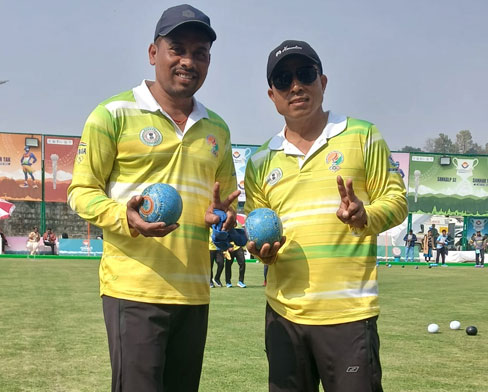


LTDP is a model based on the physical, technical, strategic, mental, emotional and cognitive development of sport participants. The priority of LTDP is Sporting Excellence and the Active for Life stage encourages lifelong physical activity. This will provide JHARKHAND BOWLING ASSOCIATION(JBA) with an opportunity to fully examine a systematic approach to player development using the LTDP key factors to evaluate current athlete development plans and adapt programs to address shortcomings.

Lawn Bowling is not only a competitive sport but also a holistic activity that promotes physical, mental, cognitive, and emotional development. Here are the major objectives in each of these areas:
For optimal performance later in life participants need to have developed their fundamental movement and motor skills before the onset of adolescence. This means that bowls relies on children and youth developing physical literacy in physical education classes and participation in a variety of sports and recreational activities. Of particular importance is the development of hand-eye coordination in target type activities.
Mastery of the fundamental bowls movements of squat, balance, bend, lunge and arm swings are necessary for elite bowlers. However the reality in bowls is that most athletes/participants take up bowls later in life and as a consequence need to learn, re-learn or improve these fundamental bowling movements. Based on their sporting, fitness or social ambition most of these fundamental bowls movements can be developed at the State Level Associations or Bowls Clubs, recognizing that modifications can be made to accommodate all participants and their abilities.
Specialization in the sport of Lawn Bowling involves an in-depth focus on developing specific skills, techniques, and strategies required to excel in the game. This includes mastering the art of delivering the bowl with precision, understanding the intricacies of the playing surface, and developing a keen sense of strategy to out manoeuvre opponents. Athletes often engage in targeted training sessions that emphasize critical aspects such as grip, stance, and follow-through, while also analyzing game footage to refine their decision-making and tactical approaches. Additionally, specialization encourages bowlers to participate in various competitions to gain experience and adapt to different playing conditions. By dedicating time to these focused aspects of the sport, players can enhance their performance, contribute to their team's success, and achieve personal milestones in Lawn Bowling.
Bowls is a late specialization sport where athletes 14 years of age are as likely as someone who is 70 years to be a world champion However, the trend in international play is to field teams with younger players than used to be the norm. It is a sport that can be enjoyed and played well into the senior years, a true ‘SPORT FOR LIFE’.
Trainability in Lawn Bowling refers to the capacity of athletes to develop and enhance their skills through structured training and practice. This sport offers a unique blend of physical and mental challenges, making it highly trainable for individuals of all ages and abilities. Key areas of focus include refining delivery technique, improving accuracy and consistency, and developing strategic thinking for effective gameplay. Training programs often incorporate drills that target specific skills, such as weight control, line accuracy, and tactical decision-making. Additionally, the mental aspect of the game—such as focus, patience, and composure under pressure—can be cultivated through visualization techniques and competitive simulations. With dedicated practice and proper coaching, athletes can significantly improve their performance, making Lawn Bowling an accessible and rewarding sport for those willing to invest time and effort into their development.
Bowls attracts participants of all ages, regardless of skill, flexibility, strength, speed or endurance, can always be trained and improved. Older adults in particular benefit from being physically active, and through their activity maintain or improve their quality of life and ability to remain independent. Older participants who wish to improve their bowls play should, like younger participants, consider engaging in off-field workouts targeting improved strength, flexibility and aerobic endurance..
It takes thousands of hours of training for an individual to become an expert in anything. These hours include time spent learning fundamental movement and fundamental sport skills in a variety of sports and other activities. Primarily, this is centred on unique, but consistent, opportunities to practice, train and compete. For bowls, there are a number of ways that an athlete could get in those many hours of deliberate practice. A bowler could enter bowls from a complimentary sport where the technical skills and physical capacities are similar.
Periodization in Lawn Bowling involves structuring training programs into distinct phases to optimize performance and prevent burnout or injury. This systematic approach typically divides the training year into several cycles: the preparation phase, where athletes focus on building foundational skills and physical conditioning; the competitive phase, which emphasizes refining techniques and strategies for peak performance during tournaments; and the transition phase, allowing for recovery and reflection after the competitive season. Each phase includes specific training goals, such as strength development, skill enhancement, and tactical practice, tailored to the athlete’s needs. By implementing periodization, players can ensure balanced training loads, maximize their potential during competitions, and maintain long-term engagement in the sport. This organized strategy not only enhances performance but also contributes to the overall development of athletes, allowing them to progress steadily while minimizing risks associated with overtraining.
Simply put, periodization is time management. As a planning technique, it provides the framework for arranging the complex array of training processes into a logical and scientifically-based schedule to bring about optimal improvements in performance.
Periodization sequences the training components into weeks, days and sessions. Periodization is situation-specific, depending upon priorities and the time available to bring about the required training and competition improvement. In the LTDP context, periodization connects the athlete’s present stage to the requirements of that stage.
For domestic play, a yearly training cycle would start in February and conclude in the late summer, again it should start in September and end till December. For international players, the yearly training cycle would be adjusted to accommodate key international events and would follow an 11-month training cycle.